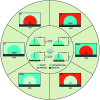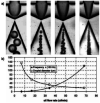Droplet microfluidics: fundamentals and its advanced applications
- PMID: 35516933
- PMCID: PMC9055587
- DOI: 10.1039/d0ra04566g
Droplet microfluidics: fundamentals and its advanced applications
Erratum in
-
Correction: Droplet microfluidics: fundamentals and its advanced applications.RSC Adv. 2020 Sep 3;10(54):32843-32844. doi: 10.1039/d0ra90086a. eCollection 2020 Sep 1. RSC Adv. 2020. PMID: 35557504 Free PMC article.
Retraction in
-
Retraction: Droplet microfluidics: fundamentals and its advanced applications.RSC Adv. 2022 Dec 1;12(53):34566. doi: 10.1039/d2ra90125k. eCollection 2022 Nov 29. RSC Adv. 2022. PMID: 36545627 Free PMC article.
Abstract
Droplet-based microfluidic systems have been shown to be compatible with many chemical and biological reagents and capable of performing a variety of operations that can be rendered programmable and reconfigurable. This platform has dimensional scaling benefits that have enabled controlled and rapid mixing of fluids in the droplet reactors, resulting in decreased reaction times. This, coupled with the precise generation and repeatability of droplet operations, has made the droplet-based microfluidic system a potent high throughput platform for biomedical research and applications. In addition to being used as micro-reactors ranging from the nano- to femtoliter (10-15 liters) range; droplet-based systems have also been used to directly synthesize particles and encapsulate many biological entities for biomedicine and biotechnology applications. For this, in the following article we will focus on the various droplet operations, as well as the numerous applications of the system and its future in many advanced scientific fields. Due to advantages of droplet-based systems, this technology has the potential to offer solutions to today's biomedical engineering challenges for advanced diagnostics and therapeutics.
This journal is © The Royal Society of Chemistry.
Conflict of interest statement
There are no conflicts to declare.
Figures










Similar articles
-
Droplet microfluidics.Lab Chip. 2008 Feb;8(2):198-220. doi: 10.1039/b715524g. Epub 2008 Jan 11. Lab Chip. 2008. PMID: 18231657 Review.
-
Droplet-based microfluidics systems in biomedical applications.Electrophoresis. 2019 Jun;40(11):1580-1590. doi: 10.1002/elps.201900047. Epub 2019 Apr 4. Electrophoresis. 2019. PMID: 30892714 Review.
-
Droplet microfluidics in (bio)chemical analysis.Analyst. 2015 Jan 7;140(1):22-38. doi: 10.1039/c4an01209g. Analyst. 2015. PMID: 25295973 Review.
-
Towards an active droplet-based microfluidic platform for programmable fluid handling.Lab Chip. 2023 Apr 12;23(8):2029-2038. doi: 10.1039/d3lc00015j. Lab Chip. 2023. PMID: 37000567 Free PMC article.
-
Droplet microfluidics-based biomedical microcarriers.Acta Biomater. 2022 Jan 15;138:21-33. doi: 10.1016/j.actbio.2021.10.037. Epub 2021 Oct 28. Acta Biomater. 2022. PMID: 34718181 Review.
Cited by
-
Microfluidics combined with fluorescence in situ hybridization (FISH) for Candida spp. detection.Front Bioeng Biotechnol. 2022 Sep 23;10:987669. doi: 10.3389/fbioe.2022.987669. eCollection 2022. Front Bioeng Biotechnol. 2022. PMID: 36213081 Free PMC article.
-
Whole genome sequencing of cyanobacterium Nostoc sp. CCCryo 231-06 using microfluidic single cell technology.iScience. 2022 Apr 25;25(5):104291. doi: 10.1016/j.isci.2022.104291. eCollection 2022 May 20. iScience. 2022. PMID: 35573199 Free PMC article.
-
Understanding the Link between Inflammasome and Apoptosis through the Response of THP-1 Cells against Drugs Using Droplet-Based Microfluidics.ACS Omega. 2022 May 2;7(19):16323-16332. doi: 10.1021/acsomega.1c06569. eCollection 2022 May 17. ACS Omega. 2022. PMID: 35601322 Free PMC article.
-
Uniform sized cancer spheroids production using hydrogel-based droplet microfluidics: a review.Biomed Microdevices. 2024 May 29;26(2):26. doi: 10.1007/s10544-024-00712-3. Biomed Microdevices. 2024. PMID: 38806765 Free PMC article. Review.
-
Technological advances for analyzing the content of organ-on-a-chip by mass spectrometry.Front Bioeng Biotechnol. 2023 May 22;11:1197760. doi: 10.3389/fbioe.2023.1197760. eCollection 2023. Front Bioeng Biotechnol. 2023. PMID: 37284240 Free PMC article. Review.
References
-
- Manz A. Graber N. Widmer H. M. Sens. Actuators, B. 1990;1:244–248. doi: 10.1016/0925-4005(90)80209-I. - DOI
Publication types
LinkOut - more resources
Full Text Sources

